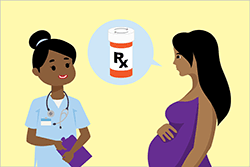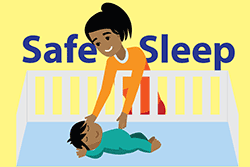Preparedness for Expectant and New Parents

Disasters, such as wildfires, hurricanes, and floods, can be unpredictable and devastating. In honor of National Preparedness Month, learn general tips to get prepared before a disaster and what to do in case of a disaster to help keep you and your family safe and healthy.
Get Prepared for an Emergency or Disaster
Disasters can be scary and stressful, especially if you’re expecting or have a baby. You can take the following steps now to help you prepare for an emergency and better cope if an emergency happens.
- Talk to your doctor or other healthcare provider about—
- What steps you should take in any emergency.
- Where you will get prenatal care if your doctor’s office is closed.
- Where you will deliver your baby if your hospital is closed.
- Learn the signs of signs of labor and prepare emergency birth kit supplies.
- Learn about your community’s warning signals (such as tornado sirens) and check with your state emergency management agency to find out how to get emergency alerts and about the best places to take shelter during different types of emergencies.
- Make a family communication plan for how you and your family will contact one another and what steps you will take in different types of situations.
- Prepare an emergency kit that includes a 3-day supply of food and water, health supplies (including any medicines you may be taking), personal and baby care items, safety supplies, electronics (flashlight, radio, cell phone with charger, and extra batteries), and important documents, such as emergency telephone numbers.
- Plan ahead for where your baby will sleep if you have to evacuate your home. Your baby is safest sleeping on his or her back on a surface that is separate from others and does not have pillows, blankets, or toys. Learn more about these and other actions at Parents and Caregivers .

Once you are out of immediate danger, continue your prenatal care even if it is not with your primary doctor.
What to Do During and Just After Disaster
Expectant Parents
Pregnant women have special medical needs. If you’re pregnant or think you may be pregnant, you and your partner can take the following steps to help you stay safe and healthy in the event of a disaster.
- If you have any signs of labor, call your healthcare provider or 911, or go to the hospital immediately if it is safe to leave.
- If you have to evacuate, be prepared to leave quickly and have your emergency kit ready to go.
- If staying at a shelter or in temporary housing, tell the staff as soon as possible that you are pregnant and if you have any health problems.
- Once you are out of immediate danger, continue your prenatal care, even if it is not with your primary doctor. Tell the doctor or other healthcare provider if you have any health problems and if you take any medications (both over-the-counter and prescription).
- If you have your prenatal vitamins or prescription medicines with you, take them as directed. If you don’t have your prenatal vitamins or prescription medicines with you, ask staff at the shelter for help getting them.
- Protect yourself from infections by washing your hands often and staying away from people who are sick.
- During disasters, harmful chemicals from businesses and other places may be released into the environment. Listen to announcements from emergency officials about chemical safety and actions you may need to take to protect yourself. If you have questions about exposure to harmful chemicals during pregnancy, call MotherToBaby at 1-866-626-6847. To reach the nationwide poison control center, call 1-800-222-1222.
- To help with physical stress, drink plenty of water and rest as often as you can. To help relieve emotional stress, talk to a healthcare provider, friend, or family member about your concerns and feelings.

Your baby is safest sleeping on his or her back on a surface that is separate from others and does not have pillows, blankets, or toys.
Parents of Infants
A disaster can make it difficult to access necessary supplies and health care. Parents and caregivers of infants can take the following steps to help keep their families safe and healthy in the event of a disaster.
- If you have to evacuate, be prepared to leave quickly and have your emergency kit that includes infant care supplies, such as baby food and a portable crib, ready to go.
- If you breastfeed your baby, continue to do so. Clean water may not be available for mixing formula or washing bottles. If you have questions about exposure to harmful chemicals while breastfeeding, call MotherToBaby at 1-866-626-6847. To reach the nationwide poison control center, call 1-800-222-1222.
- If you are away from your home during a disaster, take these actions to help your baby sleep safely .
- As soon as it is safe to do so, get a postpartum checkup if you are due for a visit, even if it is not with your usual doctor. If you’re not ready to get pregnant, you can ask for several months’ supply of the pill, patch, or ring or consider using a birth control method that will prevent pregnancy for several months.
- As soon as it is safe to do so, see a doctor or other healthcare provider for well-baby checkups or if you’re concerned about a health problem, even if it is not with your baby’s usual doctor.
- If you have your prescription medicines with you, take them as directed. If you don’t have your medicines with you, ask staff at the shelter for help getting them.
- If your baby is currently taking prescription or over-the-counter medicines, and you have them, continue giving them as directed.
- To help relieve emotional stress, talk to a healthcare provider, friend, or family member about your concerns and feelings.
More Information
- Emergency Preparedness and Response: Pregnant Women and Newborns
- Information for Pregnant Women
- Caring for Your Family in a Disaster
- Parents and Parents-to-be
- For health professionals: Emergency Preparedness and Response: Online Training Course
- To locate family: FEMA’s National Emergency Family Registry and Locator System
- Page last reviewed: September 22, 2017
- Page last updated: September 22, 2017
- Content source:
- National Center for Chronic Disease Prevention and Health Promotion, Division of Reproductive Health
- Page maintained by: Office of the Associate Director for Communication, Digital Media Branch, Division of Public Affairs




 ShareCompartir
ShareCompartir